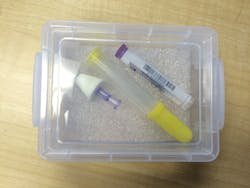Sgt. Jeffrey Felt only met the 24-year-old once, spending about five minutes with her before she was whisked away by EMS. But it was a crucial, life-or-death few minutes for the young woman, who we’ll call “Penny.” Penny’s family wrote Felt saying they were thankful he was there, calling him an “Angel in Blue.”
“No parent should have to bury his own child, but with the current heroin plague many have and yet will,” Penny’s father said in a letter to the Madison (Wisc.) Police Department. “Sgt. Felt spared us that.”
The growing opiate abuse problem in the U.S. has made pulse-less non-breather calls due to opiates more common. Opiates can cause breathing to slow so much that it stops. But naloxone helps block that reaction, returning the overdosing person’s ability to breathe.
Madison police Officer Carrie Hemming says naloxone is extraordinary for its lack of negative effects, but especially for its efficacy and speed. “It’s like sugar for a diabetic,” she says. “It’s a magical drug; it’s just that ‘Wow.’”
It was that “wow” that saved Penny. Two nasal doses of naloxone, which had been in Felt’s pocket less than a week before the overdose, got her breathing on her own again. In short order, two Midwestern police agencies discovered last year the cost—and just as quickly, the benefit—of adding the anti-opiate naloxone to the life-saving tools already on duty.
An epidemic
In an overdose emergency, timing is one of the most important factors in preserving human life. With that in mind, the police force in Wisconsin’s capital city wasted as little time as possible acting on legislation to get Narcan into sergeants’ pockets in a matter of months last year. And within a week of following through on their policy, the city had a success. A bill allowing police in Wisconsin to carry and administer the OD-reversing drug naloxone, and its branded form Narcan, had passed in April. Bill 446 was part of a group of bills in Wisconsin proposed to fight the deadly heroin epidemic that had tightened on the capital city and other areas of the state, mirroring the national drug trend of rising opiate use and consequently, overdose deaths.
National governmental health, police and drug agencies have raised red flags against the upward trend. In its 2014 National Drug Threat Assessment Summary, the Drug Enforcement Administration said there was a 37-percent increase in heroin initiates between 2008 and 2012. Of the 1,226 state and local law enforcement agencies that shared information with the DEA for the assessment, nearly one third (29 percent) said heroin was the biggest drug threat in their jurisdiction. In addition to heroin, Vicodin, OxyContin, Percocet, morphine, codeine and a few other prescription painkillers cause similar, possibly deadly, overdose symptoms. When used illicitly, the drugs are part of the national opiate use epidemic. According to World Health Organization’s data shared in November, U.S. deaths due to overdose on prescription opioids reached 16,651 in 2010, with 3,036 of deaths from heroin.
In Wisconsin, the numbers are similarly troubling. In Dane County, in which Madison serves as the county seat, rates of heroin overdose leapt from 2008 to 2012, going from between 1 to 7.9 ODs per 100,000 people to 12 to 26 per 100,000 in four years.
Madison police Capt. Tom Snyder says heroin was not such an issue when he began as an officer in the city 26 years ago, but it’s become an undeniable public safety peril.
“Certainly not just in Dane County, but statewide and nationwide. We weren’t talking about heroin 10 years ago,” Snyder says. “(Now) it’s something our officers are dealing with everyday.”
Madison’s police officials were watching closely last year as the state’s naloxone bill made its way toward law, and tapped Hemming, who had a unique medical background that would help draft the department’s policy on using Narcan in OD emergencies.
Midwestern capital city puts antidote in police pockets
Snyder says the department was lucky it already had a keystone in the city to bridge the medical world to the law enforcement one. “Carrie [Hemming] is just in the perfect spot based on all of her experiences,” Snyder says. “Carrie was the lynch pin. She did research, she consulted with other experts [and] presented a proposal for us. Put it all on paper.”
Hemming’s medical service background brought MPD a wealth of experience. She clocked 21 years in law enforcement this year, with all but one year with Madison police. But she also has 10 years experience as a firefighter and has been an EMT advanced since 1997. She says she’s a licensed practitioner nurse and is scheduled to earn her registered nurse title later this year. Long before the push for naloxone, Hemming had been teaching the department’s first aid and tactical medicine courses, which as of two years ago, take place at Madison police’s dedicated training station, the Police Training Center on the city’s east side.
Snyder says help for Hemming in drafting the department’s naloxone use policy also came from MPD’s medical director, Dr. Ashley Anderson, and the city’s fire department, whose paramedics had been administering naloxone for years.
It would have cost about $9,000 to outfit the entire nearly 450-officer sworn force with naloxone, which has an approximate 2-year shelf life and must be kept at a particular temperature, an added challenge given Wisconsin’s weather extremes. The decision to outfit MPD’s sergeants with naloxone seemed a happy medium; it would cost less to distribute to the 40-some sergeants, and they’d be responsible for keeping it on them and out of the heat and cold. The department has a minimum of two sergeants on duty who always respond to pulse-less non breather calls, so naloxone would never be too far from where it was needed.
About $1,800 later, MPD had a supply of naloxone and in early October, upper management signed off on the department’s policy, about 48 hours ahead of the sergeants’ annual training refresher. That meant Hemming could include an hour of training on when and how to administer the OD reversal drug, and how to care for the naloxone vial.
Hemming says in 2014, Madison police had arrived at the scene before the fire department about 60 percent of the 84 instances where paramedics had to distribute naloxone for an opiate-related OD. That meant the overdosing person could have received the antidote more quickly, had the officer been equipped and legally able to administer it. “That number floored me,” Hemming says. But it reinforced the mission to get naloxone into the hands of police, though the figure came several weeks after sergeants had been trained and distributed vials of the antidote.
Dash of drug carries cost, liability concern
There are a few considerations for agencies exploring a naloxone deployment. As MPD indicated, cost is a factor. Hemming says when she bought several dozen naloxone vials from distributor Bound Tree Medical in December, it was $25 per each 2mg pre-filled syringe. But that cost had already doubled by February, she said. Along with the syringes, the department also needed nasal atomizer tips and push injectors to deliver naloxone via the patient’s nose. A cost Hemming didn’t initially account for was how the sergeants would transport the three-piece kits. So she had to get creative and bought a mix of small plastic boxes and travel toothbrush containers to protect the drug but keep it lightweight and mobile. She said area dollar stores had a variety of solutions for little cost.
Related to cost, the naloxone has a shelf life of about two years. That means another big buy next year to replace whatever units are not used before then. Plus the naloxone has to be kept between 59 and 86 degrees Fahrenheit. Wisconsin winters stray far below 59 degrees for months, and its summers can commonly spike up over 86 degrees. That means the naloxone kits go in and out of the squad with the sergeants at the top and end of each shift to keep them at regulated temperatures.
Another issue that came up in Madison was officer liability. In the bill Wisconsin legislators wrote, they specifically used language that “any person who administers the drug is immune from civil or criminal liability provided their actions are consistent with Wisconsin’s Good Samaritan law.”
“Liability wise, I’m not concerned based upon the legislation that was approved,” Snyder said. “I think we are covered in terms of that.”
Defibrillators inspire anti-opiate tool
At the end of last year, a short distance south of Madison, across Wisconsin’s border with Illinois, another police agency was about to garner its first overdose save using an anti-opiate. Deerfield, Illinois is a well-to-do suburb of Chicago, a bedroom community that doesn’t see a lot of felony crime, Deputy Chief Tom Keane says. In November, Deerfield received a version of naloxone that’s delivered via needle injection through a specially made device called EVZIO, which was designed for non-medical users.
“The technical operation part of it, you could open it up and use it without any training,” Keane says. “This is just so easy.”
Dr. Eric Edwards, cofounder of the Virginia-based pharmaceutical company, Kaleo, says the EVZIO naloxone auto-injector was developed to include visual and voice instructions. He says the idea to came from another common first-aid tool that law enforcement knows well: the automated external defibrillator. “That was one of the inspirations behind the audible prompt system,” Edwards says. “We saw a real opportunity (using) audible and visual cues.”
Keane says he sees naloxone joining AEDs as an essential part of police first-aid kits. Though AEDs are an expensive investment, costing between $1,200 to $2,500 today, the technology proved itself vital. “Years ago when they implemented AEDs, we were one of the first departments to carry the AEDs,” Keane says. “We didn’t have it too long before we used it. A kid took a line drive baseball to the heart, stopped his heart right there on the pitcher’s mound. We got a save out of that one. So we’ve always been proactive on life-saving technology.”
Deerfield PD, with 40 sworn officers, doesn’t have EVZIO issued per officer, but instead per squad vehicle, so that there are always doses out on patrol. Deerfield was one of several departments in Lake County, Ill., to receive several EVZIO units through Kaleo’s donation program, Kaleo Cares. The units were procured from Kaleo by the county’s opioid initiative group. The total donation was worth $1.4 million, according to the Dailyherald.com. Deerfield received a portion of the donated injection devices in November. Seven weeks later on Christmas Day, Deerfield officers used EVZIO to save the life of a woman who was visiting a village of Deerfield resident.
Edwards says although it’s a for-profit company, Kaleo recognizes the need for the first responder on scene to have the anti-opiate. That’s why EVZIO was developed in the first place and also why it developed the cares program to help, he says. Edwards would not share a price for EVZIO units, but said Kaleo recently partnered with the Clinton Foundation to provide a discount to universities, public safety and community organizations in the United States.
MPD anti-opiate path uncertain
Hemming says with the help of colleagues, MPD was able to get naloxone out with sergeants by the end of the year, and even save two lives by the end of December 2014. But the swift implementation meant that financially, the department’s budget isn’t in any shape to continue its naloxone protocol. “We rolled this out before we had all the answers,” Hemming says. “We just have more needs than we have budget, and it’s nobody’s fault. Do we have the money to continue it? ‘No’ is honest; ‘Not yet’ is hopeful.”
Hemming says MPD applied for EVZIO’s cares program, and if the department was awarded it, she’d be happy to retool the training and deliver naloxone by needle versus nasal.
Making a positive difference
Felt says like with many of the calls he goes on, he tends to not dwell on them afterward. Albeit it a call with a positive outcome, it was that way with the Nov. 21 drug incident. He says he was doing his job, and administering the naloxone was easy. But then the heartfelt letter of thanks came from the family: “Sgt. Felt saved our dying daughter’s life. Sgt. Felt used his admirable skill, judgment, poise and training amidst the chaos to administer the recently supplied antidote. Mere words cannot describe our deep, abiding gratitude for his miraculous efforts.”
“To get that letter from the family … I’m sure they’ve been battling this for a while. I’ve got kids her age, it made it hit home,” Felt says. “I’m proud of what I do everyday. Everyone that gets into this profession is trying to make a difference, and a positive difference, in some way.”
Tabatha Wethal is a former Law Enforcement Technology editor working as a daily news reporter in Madison, Wisconsin. Reach her at [email protected].



